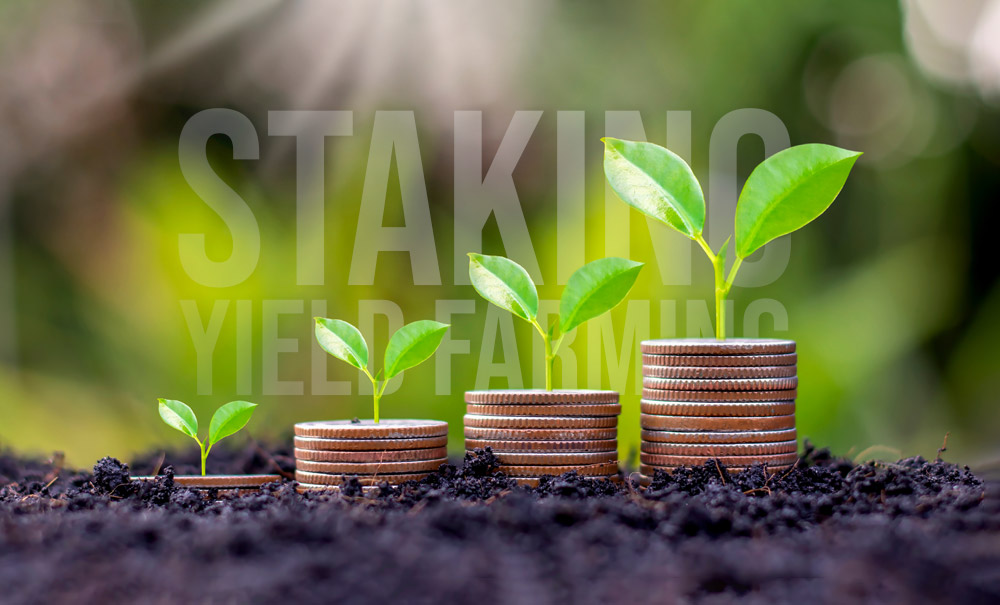Crypto staking is locking up crypto holdings to obtain rewards or earn interest. The reward mechanism differs depending on the type of cryptocurrencies and their blockchain networks. There are different approaches such as “proof-of-stake” or “proof-of-work.” These processes help crypto networks achieve consensus or confirmation that all transaction data adds to what it should.
What are Staking and Yield Farming?
– Staking
When we look at the skyrocketing growth and development in the crypto market, especially the Ethereum ecosystem -the platform in which most of the innovations formed- we observe tiny changes in the market rules and protocols that might look the same as the previous ones. But professional individuals and market participants can get the key and catch the opportunities.
Yield Farming, Staking, Liquidity Mining are concepts that we consider passive income, which we will briefly explain below.
We will start with “staking” in fact, a Stake is a share used in the system based on PoS (Proof of Stake); it happens when someone intends to confirm new blocks and participate in the consensus of a network.
Therefore, it guarantees deposited assets or (so-called Stake) to increase. The beneficiary gets the agreed or promised amount of the token or fiat based on the interest rate. This system pays back people who have lost all or part of their assets resulting from wrongly occurred transactions by the system.
– Yield Farming
Yield farming is one of the new concepts in Defi. It happens when a temporary deposit of a specific asset, including tokens or coins, is deposited by market participants in some protocols or platforms like exchanges or lending platforms.
The Service provider or the protocol system will pay back the profit to the customers of the services in return.
To achieve more profit, people need to get more loans and re-borrow with support of your assets, which we initially placed in the pools, and deposit the Digital assets to receive more profit, which increases the risk. Keep in mind that the risk of liquidation is always there; for example, it is most likely that unskillful market participants will lose all of their assets in a blink.
The interest rate in Yield farming will be calculated by the APY unit (Annual Percentage Yield), a compound interest. The overall interest rate of this farming is very variable, and the more liquidity in these pools and the more participants in these pools, the lower the interest rate. Finding high-profit farms usually requires a lot of effort, which is beyond the reach of the average Defi users.
– Liquidity Mining
As the name implies, liquidity mining improves and increases liquidity in Defi protocols, which motivates market participants to provide liquidity in the protocol by creating a series of incentives at the project level. This liquidity is used to provide liquidity for transactions and trades. They are also given LP tokens (LP tokens represent a crypto liquidity provider’s share of a pool), but it is not used for lending and borrowing operations, unlike liquid farming.
When the user doesn’t intend to provide liquidity anymore, give back the LP tokens to the protocol. Instead of those, take some governance tokens and release their liquidity.
All these three are similar concepts, but you must decide between them based on your taste, amount of assets, and risk you can take.
Conclusion
When a crypto investor stakes their holdings (in other words, leaves them in their crypto wallet or registered crypto accounts), the network can use their holdings to mine new blocks on the blockchain faster. The more crypto they’re staking, the better the odds are their holdings will be selected. Yield farming is one such investment strategy in Defi. Yield farming is comparable to Staking because both need to hold some crypto assets to yield profits. Some investors consider Staking to be a part of yield farming. Yield farming involves lending or staking your cryptocurrency coins or tokens to get transaction fees or interest rewards. Yield farming is similar to earning interest from a bank account, and investors technically lend money to the bank.
